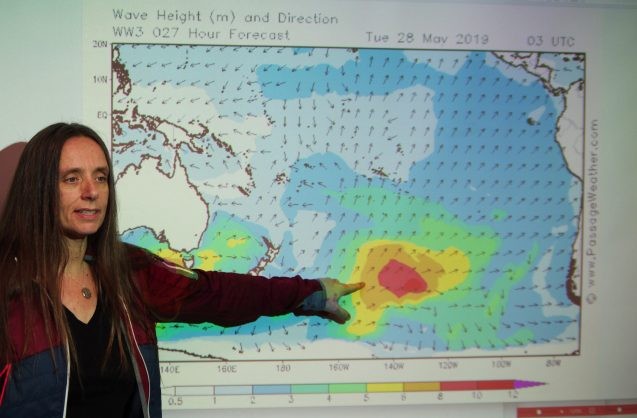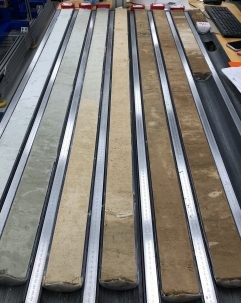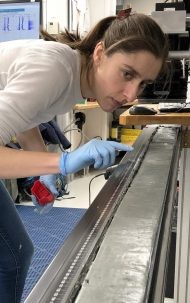After a Long Wait, Expedition 383 Drills its First Seafloor Core
It took six days to sail to Point Nemo, the most inaccessible point of the ocean on this planet, to drill a sample from the ocean floor.

By Julia Gottschalk
Patience is not my strongest asset. For years I have been excited about this opportunity to sail on the JOIDES Resolution with some of my greatest colleagues and to uncover the well-kept secrets of Southern Ocean climate variability. Everyone from the science party as well as the technical and support teams had boarded, supplies were stored in the hull, and the goals were clear. However, at the beginning of our expedition, we found ourselves on a very long ride to our first drill site near Point Nemo, which condemned us to wait another six days before we could start our drilling operations. That definitely tested our patience — in particular mine.
The long way to Point Nemo was understandable, since it is the most inaccessible point of the ocean on this planet. In fact, it would have taken a long time from anywhere to get to our first drilling site in the Central South Pacific, which is 1500 miles away from the southern tip of South America, where we set sail. With every day during the transit to Point Nemo, our distance from land increased and so did our excitement and spirits.

There is a strategic reason to come all the way to the central Pacific and face the treacherous and windy latitudes of the Southern Ocean. This is the best place to study the variability of the Antarctic Circumpolar Current and deep ocean circulation dynamics in the Southern Pacific, because the climate records that monitor those changes are less overprinted by the accumulation of material from land. There are also small bathymetric pockets at the bottom of the sea floor that have allowed for undisturbed accumulation of sediments from the overlying water column, layer by layer, over thousands and millions of years. None of us could wait to retrieve those sediments on the JOIDES Resolution, and study those precious climate archives.
Our six-day transit was filled with intensive preparations for the upcoming drilling operations and for the first arrival of “core on deck,” as well as with getting our bodies used to the rough seas. (The latter was quite a process for some.) Expedition 383 is a once-in-a-lifetime chance to sample these climate archives, and everyone wanted to make it count.
Everything on the JOIDES Resolution is centered around receiving, measuring, describing, archiving and storing away sediment cores. The order of measurements and hands that a core goes through is stringently coordinated in what we call the “core flow.” Everybody knows exactly what to do, when and why.
At last, when the drillers pulled up the first core from the sea floor, the technical team of the JOIDES Resolution received, labeled and cut the 10 meter-long-core into 1.5-meter segments. Our friends from the physical property group started to measure the physical parameters of the unopened cores with multi-sensor loggers, without actually touching or consuming the sediment. They are interested in the density, heat conductivity, magnetic behavior and natural radioactivity of the sediments, which already quite impressively characterizes the sediment composition and water content. Our physical property specialists on board easily produce 6000 data points in an hour.
Video: The IODP technical team of Expedition 383 carries the first 10-meter drill core from the drill rig into the entry laboratory area of the ship, which we call the catwalk. Credit: Jenny Middleton/Lamont-Doherty Earth Observatory
After the physical property team scanned the whole core, each core section was split in half from top to bottom. One half, known as the “working half,” provides sample material for additional analyses. The second half, known as the “archive half,” is preserved for the future.
Video: Sedimentologists of Expedition 383 describe in detail every visible change in the drill cores in the core laboratory of the JOIDES Resolution. This includes lithological, color and structural changes. Credit: Julia Gottschalk/Lamont-Doherty Earth Observatory

As one of the sedimentologists, I am lucky to be one of the first scientists on board to set eyes on the split sediment core surfaces as soon as the archive halves are brought to our description table. It gets really busy in the core lab at that time. We assess the color, the sedimentary structures and types of sediments, and we meticulously document our results in the IODP database for everyone to access. We use multi-sensor loggers to generate additional records of the sediment color and magnetic properties. As a team, we also start to take the first samples from distinct layers of the working half for shipboard analyses, in order to get a quantitative assessment of the sediment composition and chemical parameters. Having scanned the core by eye and with our instruments, we start to discuss the past environments that the sediment layers in the core might actually reflect: Do brownish layers reflect a dustier world? Are the white layers indicative of a Southern Ocean with more biologic activity than at present-day? Does coarser material in the core mean a faster Antarctic Circumpolar Current in the past?
We were barely finished with measuring, sampling and documenting our first core from the Central South Pacific when the drillers announced “Core on deck” again through the ship’s loudspeaker system. I can only anticipate how we will feel at the end of our expedition, when we have analyzed and documented our target of 5000 meters of core. I already feel exhausted, yet I am super excited about the first 10 meters we retrieved and cannot wait to see and study the next 4990 meters!
Julia Gottschalk is a post-doctoral researcher at Lamont-Doherty Earth Observatory (@Jul_Gottschalk).
